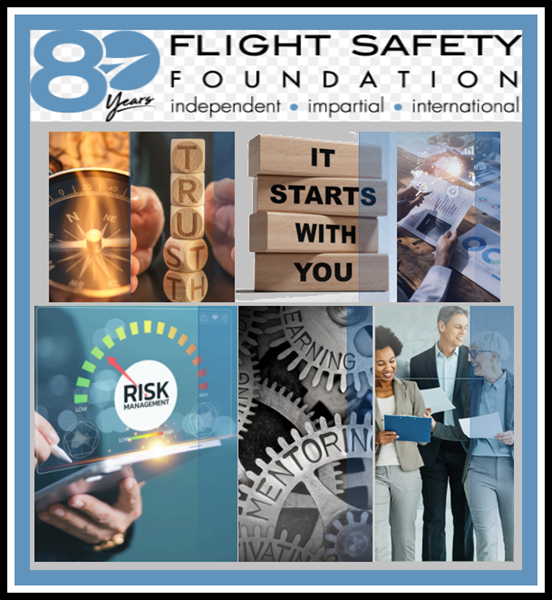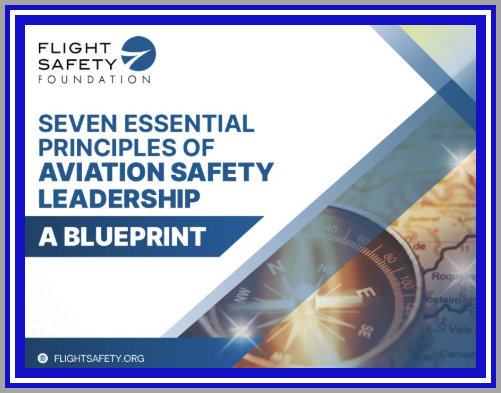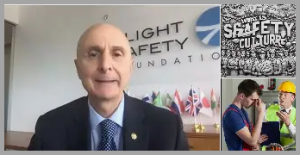FSF’s 7 Principles of Aviation Safety, THE SMS BIBLE?

SMS and Safety Culture must be a “way of life” or a “core organizational value”—something that must be lived, modeled, and reinforced at every level. It’s not about belief for belief’s sake—it’s about shared responsibility, vigilance, and ethical action. There is NO BIBLE for this mental discipline NOR A TEXTBOOK for the vigilance/consciousness which this risk management regimen demands. In the absence of a well known resource to support SMS, NOW, Flight Safety Foundation has created such a REFERENCE. As FSF stated, it is “rooted in decades of global research and operational experience…”
Click on this link ↓↓↓ to full report that everyone– involved in aviation and thus committed to AVIATION SAFETY– must read
Seven Essential Principles of Aviation Safety Leadership
This synopsis is NOT adequate to truly inculcate the principles that will motivate your individual safety culture and inspire your sharing of them with your team. PLEASE CLICK AND READ ALL 10 PAGES OF FLIGHT SAFETY FOUNDATION’S WISDOM
![]() in summary, executives must lead by example: When leaders champion safety unequivocally, the entire organization is inspired to follow.
in summary, executives must lead by example: When leaders champion safety unequivocally, the entire organization is inspired to follow.
When the workforce trusts that management will respond to safety issues constructively and that honest mistakes will be treated fairly, invaluable information flows freely. This enables the organization to identify and address latent risks before they lead to accidents
![]() Accountability is a cornerstone of safety leadership. Aviation executives must establish and uphold a governance structure that assigns clear responsibility for safety at every level of the organization — including themselves. IN PRACTICE,[1] THIS BEGINS WITH THE DESIGNATION OF AN ACCOUNTABLE EXECUTIVE (often the CEO[2] or a top executive), who is ultimately answerable for the performance of the company’s safety management system (SMS) and overall safety outcomes.
Accountability is a cornerstone of safety leadership. Aviation executives must establish and uphold a governance structure that assigns clear responsibility for safety at every level of the organization — including themselves. IN PRACTICE,[1] THIS BEGINS WITH THE DESIGNATION OF AN ACCOUNTABLE EXECUTIVE (often the CEO[2] or a top executive), who is ultimately answerable for the performance of the company’s safety management system (SMS) and overall safety outcomes.
Safety should never be seen merely as a regulatory obligation or a stand-alone program. Instead, safety considerations must be FULLY INTEGRATED into business decisions, strategic planning, and day-to-day operational management. Executives who integrate safety strategically ensure that their organizations proactively manage risks, turning safety into a long-term competitive advantage rather than a cost center.
In other words, executives must make sure their organization has the skilled personnel, analytical tools, and decision-making processes to continuously hunt for weak signals and emerging hazards in the operation.![]()
A learning organization in aviation is one that diligently learns from its own experiences and from industrywide insights. Executives should promote thorough investigations of incidents, near-misses, and even deviations from standard procedures, with the goal of extracting lessons and preventing recurrence. The findings from internal incident reviews or from notable events in the wider industry should be translated into updated procedures, training, or technology improvements. It is THE LEADER’S ROLE to ensure that lessons learned are effectively captured and disseminated across the organization.
Effective communication and engagement are vital to enacting the above principles and sustaining a strong safety culture. Aviation executives must be champions of safety communication, ensuring that safety remains an active, ongoing conversation within the organization and that every employee is engaged in the mission of safety…
Beyond top-down communication, engagement is a two-way street. Executives need to actively listen to employees and involve them in safety efforts. This can be done by establishing channels for feedback, such as regular safety meetings, suggestion systems, or confidential reporting lines, and by PERSONALLY PARTICIPATING IN SAFETY WALKTHROUGHS OR DISCUSSIONS. For example, a CEO or senior executive[3] might periodically visit airport ramps, factory floors, maintenance hangars, or cockpits during training sessions — not only to show visible support for safety but also to hear directly from staff about their safety concerns and ideas…
Application of FSF’s seven principles of SMS provide TREMENDOUS GUIDANCE for any aviation enterprise establishing or reassessment of the team’s commitment. Sizing them for your team involves some objective judgments, hard for an organization to make because your opinions about what your needs may be are, by definition, subjective. Similarly, examining your own organization’s degree inculcation of the FSF 7 as a matter of constant awareness of your peer employees is difficult to make because the internal auditor, for example, may involve calling out the deficiencies of a co-worker. Outside assistance, particularly from an experience team, insures a better portrait of your Aviation Safety Leadership.
Foundation Unveils Seven Principles of Aviation Safety Leadership
Global engagement campaign to launch at IASS 2025 in Lisbon.
by FSF Communications Staff | October 16, 2025
ALEXANDRIA, Va. — Flight Safety Foundation today unveiled the “Seven Essential Principles of Aviation Safety Leadership,” a practical framework to help aviation organizations embed safety into governance, culture, and strategy — from the boardroom to the front line. Rooted in decades of global research and operational experience, the principles reflect a SIMPLE TRUTH: Aviation’s remarkable safety record is FRAGILE and demands CONSTANT VIGILANCE, with leadership setting the tone for priorities, resources, and behavior.
“Safety isn’t sustained by systems alone — it is shaped daily by values, decisions, and behaviors at every level,” said Dr. Hassan Shahidi, president and CEO of Flight Safety Foundation. “These seven principles translate leadership into action. When executives walk the talk, integrate safety into strategy, and cultivate a climate of trust and accountability, organizations become more resilient — and accidents become more preventable.”
The principles outline what leaders must do to demonstrate commitment to safety; foster a positive just culture built on trust and transparency; clarify accountability and governance; integrate safety into corporate strategy; promote proactive risk management and accident prevention; drive continuous learning and improvement; and communicate, engage, and empower people at all levels.
The Foundation will roll out the principles at the 78th International Aviation Safety Summit (IASS), to be held November 4–6, 2025, in Lisbon, Portugal. The Summit will feature leadership dialogues, case study discussions, and practical takeaways to help organizations put the principles to work immediately. To register, click here to access the IASS 2025 page on the Foundation’s website.
To accelerate adoption of the principles, the Foundation is launching a global campaign that engages the entire aviation community and will include webinars, workshops, and polls designed to identify what works, reveal gaps, and develop shared benchmarks.
The Foundation also has developed a survey to see how the principles are working in organizations across the industry. Please click here to access and complete the survey.
“Our aim is to make safety leadership visible, measurable, and repeatable,” Shahidi said. “By aligning governance, strategy, and day-to-day decision-making with these principles, we can strengthen safety cultures, enhance accountability, and drive risk down across the system.”
###
About Flight Safety Foundation (flightsafety.org)
Flight Safety Foundation is an independent, nonprofit, international organization engaged in research, education, and communications to improve aviation safety. The Foundation’s mission is to connect, influence, and lead global aviation safety.
Media Contact:
Frank Jackman
Director, Communications and Research
+1 703.739.6700, ext. 116
jackman@flightsafety.org
**********************************************************************************
[1] 14 CFR § 5.25(a) — Designation of the Accountable Executive
Any person required to implement an SMS under Part 5 must identify an Accountable Executive who:
- Has final authority over operations conducted under the certificate(s) or Letter(s) of Authorization.
- Controls the financial resources necessary for those operations.
- Controls the human resources required for those operations.
- Retains ultimate responsibility for the safety performance of those operations.
[2] While this is factually correct, experience has shown that the CEO is too busy to create the PRESENCE on the Flight Line, Hangars, etc. Here is a brief explanation of the daily duties of THE AE– e AE MUST ESTABLISH A REAL SAFETY CULTURE She/He must be is visible to all, establish clear policies and procedures. The AE allocate resources ensuring that safety is an integral part of the organization. She or he must foster an environment where employees are empowered to prioritize safety without fear of reprisal. As trust is a cornerstone of effective safety leadership. AEs must earn the trust of the employees, enabling smoother implementation of safety policies and obtaining necessary approvals. When trust exists, employees are more likely to comply with safety instructions and procedures. While safety managers focus on compliance with regulations, AEs must actively promote safety as a core value. They seek ways to enhance safety protocols and mitigate hazards proactively, rather than merely reacting to incidents.
[3] See footnotes 1 and 2; these interactions should not just be SHOWS. The AE’s presence needs to devote time- intaking safety concerns from all levels of the organization, analyzing the risks flagged and involving the SMS team and/or the individual who brought it to the AE’s attention. The feedback must be an honest, transparent discussion of the remedial steps considered and the reasons why/why not they were implemented. Its this interaction that inculcates the SAFETY CULTURE throughout the team. CEOs are not likely to have the time to devote to this UP-DOWN-UP communication. The senior executives must truly understand SMS and be aware of the company’s commitment. Yes, the C Suite officers must frequently pen messages from the SMS Bible .








